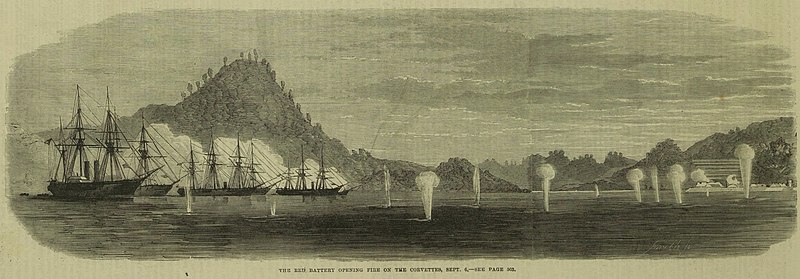File:The Red Battery opening fire on the corvettes, Bombardment of Shimonoseki, the War in Japan - ILN 1864 (cropped).jpg

Original file (2,172 × 757 pixels, file size: 397 KB, MIME type: image/jpeg)
Captions
Captions
Summary edit
| Frederick James Smyth: The War in Japan
( |
|||||||||||||||||
|---|---|---|---|---|---|---|---|---|---|---|---|---|---|---|---|---|---|
| Artist |
artist QS:P170,Q52231668 from sketches by special correspondent C. Wirgman |
||||||||||||||||
| Author |
The Illustrated London News |
||||||||||||||||
| Title |
The War in Japan |
||||||||||||||||
| Description |
English: The War in Japan. Illustration for The Illustrated London News, 19 November 1864. Acton of Sept. 5, in the Strait of Simonosaki. The Red Battery opening fire on the corvettes, Sept. 6.
|
||||||||||||||||
| Depicted place | Japan | ||||||||||||||||
| Date |
19 November 1864 date QS:P571,+1864-11-19T00:00:00Z/11 |
||||||||||||||||
| Medium | Wood engraving | ||||||||||||||||
| Place of creation | London | ||||||||||||||||
| Source/Photographer | The Illustrated London News | ||||||||||||||||
| Other versions |
|
||||||||||||||||
Licensing edit
|
This is a faithful photographic reproduction of a two-dimensional, public domain work of art. The work of art itself is in the public domain for the following reason:
The official position taken by the Wikimedia Foundation is that "faithful reproductions of two-dimensional public domain works of art are public domain".
This photographic reproduction is therefore also considered to be in the public domain in the United States. In other jurisdictions, re-use of this content may be restricted; see Reuse of PD-Art photographs for details. | |||||
File history
Click on a date/time to view the file as it appeared at that time.
| Date/Time | Thumbnail | Dimensions | User | Comment | |
|---|---|---|---|---|---|
| current | 15:09, 10 March 2021 | 2,172 × 757 (397 KB) | Broichmore (talk | contribs) | File:The War in Japan - ILN 1864.jpg cropped 8 % horizontally, 53 % vertically using CropTool with lossless mode. |
You cannot overwrite this file.
File usage on Commons
The following 2 pages use this file:
File usage on other wikis
The following other wikis use this file:
- Usage on en.wikipedia.org
Metadata
This file contains additional information such as Exif metadata which may have been added by the digital camera, scanner, or software program used to create or digitize it. If the file has been modified from its original state, some details such as the timestamp may not fully reflect those of the original file. The timestamp is only as accurate as the clock in the camera, and it may be completely wrong.
| JPEG file comment | Created by AccuSoft Corp. |
|---|
